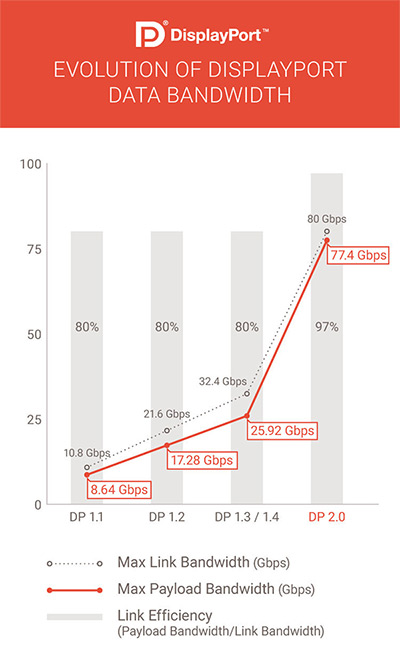VESA has today taken the wraps off a new version of DisplayPort, ramping the version number up from 1.4 to 2.0. This is the first major revision since the previous version was released in March 2016.
The main feature of DisplayPort 2.0 is its ability to handle triple the effective bandwidth of DisplayPort 1.4 – a massive 77.4Gbps.

That will allow for displays of anything up to 16K resolution which is mind boggling to say the least. Improved refresh rates and support for HDR at high resolutions will also be made possible thanks to that huge bandwidth potential.
VESA says that this was only made possible by the use of Thunderbolt 3, allowing DisplayPort 2.0 to be the first to support 8K resolutions at a buttery smooth 60Hz all while retaining support for full-color 4:4:4 and HDR10. That covers all of the buzzwords you could possibly want from something like this, and it’s sure to be pretty awesome.
Configurations include:
Single display resolutions
– One 16K (15360×8460) display @60Hz and 30 bpp 4:4:4 HDR (with DSC)
– One 10K (10240×4320) display @60Hz and 24 bpp 4:4:4 (no compression)Dual display resolutions
– Two 8K (7680×4320) displays @120Hz and 30 bpp 4:4:4 HDR (with DSC)
– Two 4K (3840×2160) displays @144Hz and 24 bpp 4:4:4 (no compression)Triple display resolutions
– Three 10K (10240×4320) displays @60Hz and 30 bpp 4:4:4 HDR (with DSC)
– Three 4K (3840×2160) displays @90Hz and 30 bpp 4:4:4 HDR (no compression)

VESA also says that we can expect DisplayPort 2.0 to be available via USB-C, Thunderbolt 3, and DisplayPort itself. It’s unclear when we can expect devices to start to take advantage of this new standard, but it seems tailor made for displays like Apple’s upcoming Pro Display XDR.
You may also like to check out:
- Download iOS 13 Public Beta And Install The Right Way, Here’s How
- iOS 13 Public Beta 1 Profile Download Along With iPadOS 13, tvOS 13 And macOS Catalina Released To Testers
- 100+ iOS 13 Hidden Features For iPhone And iPad [Running List]
- How To Downgrade iOS 13 / iPadOS 13 Beta To iOS 12.3.1 / 12.4
- iOS 13 Public Beta 1 Download Release Date Announced Along With macOS 10.15, tvOS 13 Public Betas
- iOS 13, iPadOS Compatibility For iPhone, iPad, iPod touch Devices
- iOS 13 Beta 1 Download IPSW Links, OTA Update And iPadOS 13 Beta 1 For iPhone And iPad
- Download iOS 13 Beta 1 IPSW Links & Install On iPhone XS Max, X, XR, 8, 7, Plus, 6s, iPad, iPod [Tutorial]
You can follow us on Twitter, or Instagram, and even like our Facebook page to keep yourself updated on all the latest from Microsoft, Google, Apple, and the Web.

